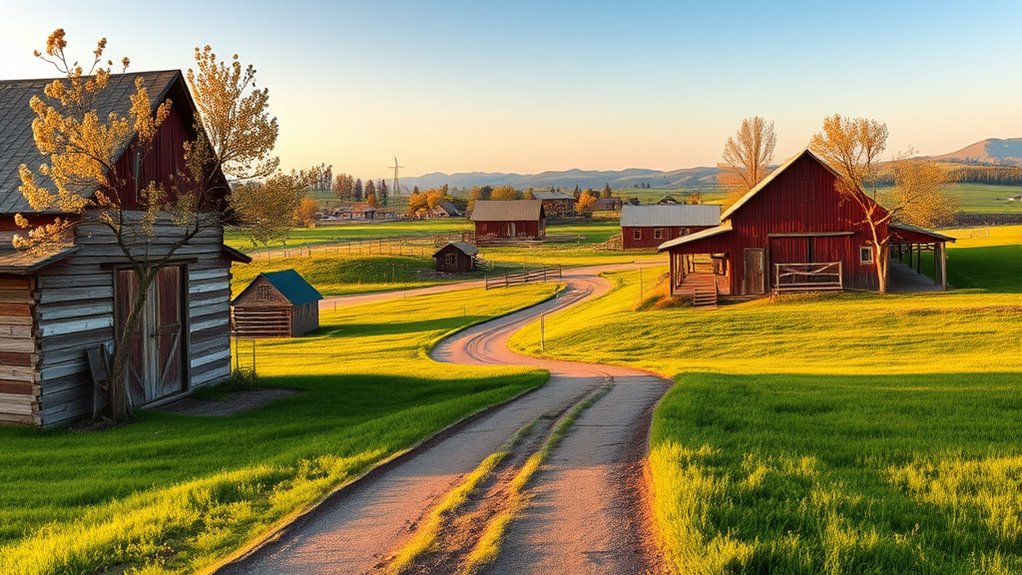Oregon Trail farmsteads show how early settlers turned rugged claims into vibrant communities through resilience and resourcefulness. You can see simple but sturdy homes built from local materials like logs and sod, reflecting the pioneering spirit. These structures fostered social ties, support networks, and local institutions, transforming isolated claims into thriving towns. Exploring their history reveals the resilience of frontier life, and if you stay curious, you’ll uncover even more about how these communities grew from basic settlements.
Key Takeaways
- Oregon Trail farmsteads evolved from simple claims into thriving community hubs with shared resources and local institutions.
- They showcase pioneer architecture built with locally available materials emphasizing durability and resourcefulness.
- Preservation efforts focus on maintaining authentic structures to understand early settler resilience and craftsmanship.
- Farmsteads served as centers of social life, supporting community formation through schools, churches, and support networks.
- These historic sites connect visitors to westward expansion, highlighting pioneering spirit, ingenuity, and collective effort.

Oregon Trail farmsteads stand as enduring symbols of the pioneer spirit that shaped the American West. When you explore these sites, you’re stepping into a living piece of history, where early settlers carved out communities from the rugged landscape. Many of these farmsteads showcase pioneer architecture, reflecting the resourcefulness and practicality of those who built them. Simple, sturdy, and functional, these structures often used locally available materials like logs, sod, and rough-hewn timber. Their design prioritized durability and efficiency, allowing settlers to withstand harsh weather and the test of time. As you walk through these farmsteads today, you can appreciate how their architecture embodies the resilience of early pioneers, standing as a testament to their ingenuity and tenacity.
Preserving these historic farmsteads is essential for understanding the roots of westward expansion. You might notice that many of these sites have been carefully maintained or restored through historic preservation efforts. These projects aim to retain the authentic character of the original structures while making them accessible for future generations. Without such efforts, many of these historic buildings risk deterioration or loss, erasing important links to the past. When you visit, you’ll see how preservationists work diligently to stabilize foundations, repair weathered wood, and protect the farmsteads from decay. Their work helps keep the stories of the pioneers alive, offering you a tangible connection to the challenges and triumphs faced by those who settled the frontier. Additionally, incorporating authentic construction techniques ensures that restorations remain true to the original craftsmanship.
Preserving farmsteads maintains their historic character and connects us to pioneer stories and westward expansion.
The process of transforming a simple claim into a thriving community often involved more than just building a homestead. As settlers established farms, they created networks of support, shared resources, and developed local institutions like schools and churches. These farmsteads served as the nucleus of new towns and communities, shaping the social fabric of the West. Today, many of these sites are recognized as historic landmarks, with interpretive displays and guided tours that help you understand their significance. By engaging with these preserved farmsteads, you gain insight into the daily lives of the pioneers, from raising crops and livestock to participating in community events. The farmsteads stand as a symbol not only to individual perseverance but also to collective effort in forging a new life on the frontier.
In the end, Oregon Trail farmsteads connect you directly to the pioneering spirit that drove westward expansion. Their enduring structures and ongoing preservation efforts serve as powerful reminders of how resilience, ingenuity, and community spirit transformed the rugged wilderness into thriving towns and farms. When you visit these historic sites, you’re not just observing old buildings—you’re experiencing the heart of the American frontier story firsthand.
Frequently Asked Questions
How Did Farmsteads Evolve Over the Decades in Oregon Trail Regions?
Over the decades, farmsteads in Oregon trail regions evolved through changing settlement patterns and community development. You see, initial homesteads started small but expanded as families settled deeper into the land. As more settlers arrived, these farmsteads grew into vibrant communities, with improvements in infrastructure and shared resources. This evolution reflects how settlement patterns shift over time, fostering stronger community bonds and more sustainable, productive farmsteads in Oregon trail regions.
What Were the Primary Crops Grown on These Early Farmsteads?
Like pioneers planting their flag, you’ll find wheat and potatoes as the primary crops on these early farmsteads. They relied on historic crop varieties, using simple farming techniques passed down through generations. Corn and beans also played essential roles, nourishing families and shaping the landscape. These crops reflect the resilience and resourcefulness of settlers, who adapted their methods to thrive in the frontier’s challenging conditions, forging communities from seed and soil.
How Did Settlers Acquire Land for Their Farmsteads?
You acquire land for your farmstead mainly through settler land grants, which the government issued to encourage westward expansion. These land grants often involved applying through government programs like the Homestead Act, allowing you to claim and develop a plot. Land acquisition methods also included purchasing from other settlers or land speculators. By securing a land grant, you gain official ownership, enabling you to establish and grow your farm community.
What Architectural Styles Are Common in Oregon Trail Farmsteads?
You’ll notice that Oregon Trail farmsteads often feature log cabin architecture, showcasing simple, sturdy construction using local timber. Additionally, Victorian farmhouse styles became popular as settlers prospered, adding decorative trim, gabled roofs, and spacious porches. These architectural styles reflect the blend of practicality and aesthetic appeal, with log cabins emphasizing durability and Victorian influences highlighting prosperity and community pride during different settlement phases.
Are There Any Preserved Historic Farmsteads Open to the Public Today?
You might find yourself surprised to discover that several historic farmsteads are open for public tours today. Thanks to preservation efforts, places like the Reed Farmstead and the Dorris Ranch offer engaging historic tours that bring the past to life. These sites preserve Oregon Trail farmsteads’ legacy, allowing visitors to experience early pioneer life firsthand. Don’t miss the chance to explore these well-maintained landmarks and connect with history firsthand.
Conclusion
As you walk through these farmsteads, you see history carved into every corner—struggles and triumphs intertwined. What once was a lonely claim now hums with life, a thriving community. The hardships of the past stand in stark contrast to today’s resilience and growth. You realize that from humble beginnings, a vibrant future can emerge. These farmsteads remind you that persistence transforms dreams into enduring legacies, bridging history and hope in every breath.










